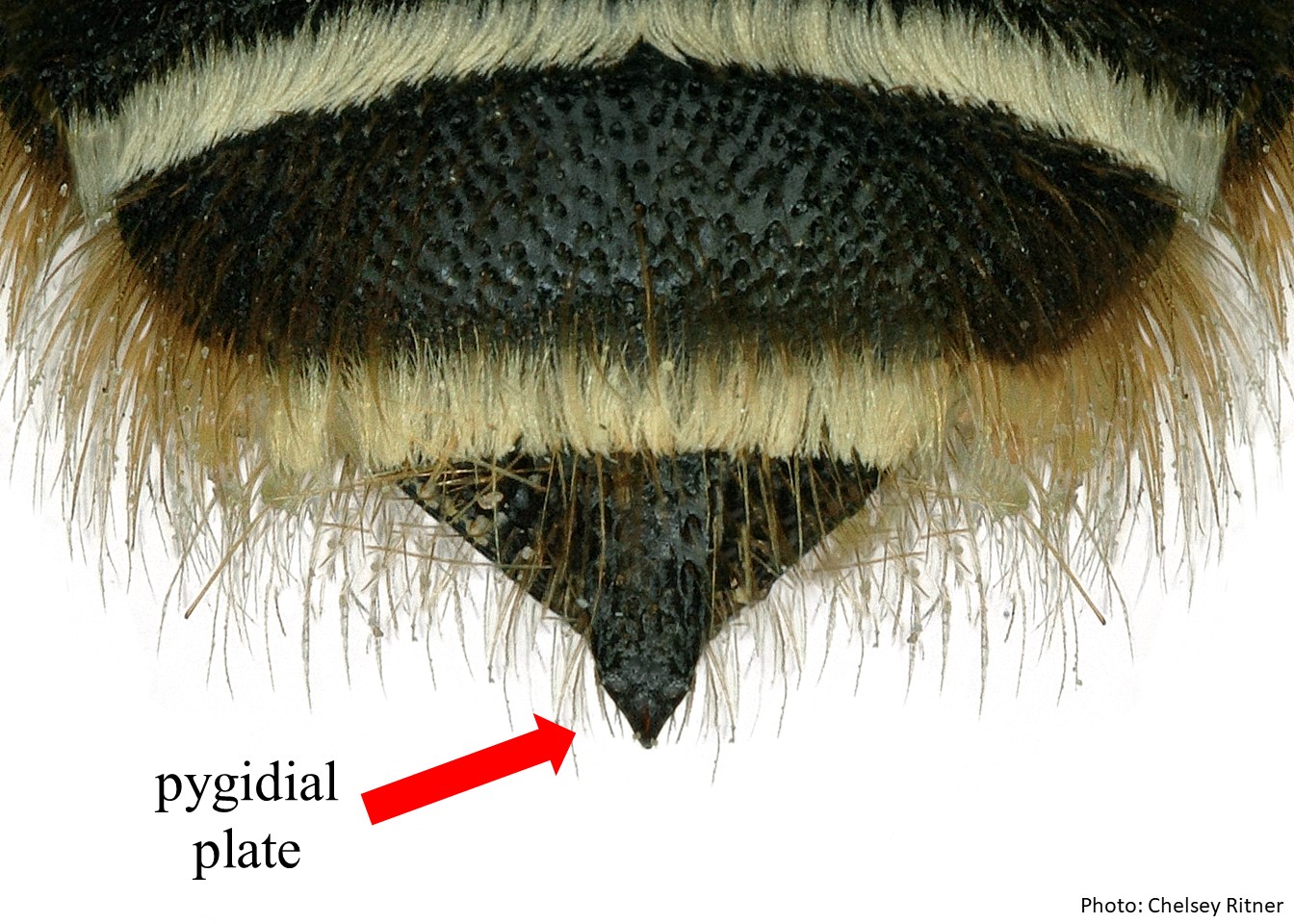Family: Apidae
Subfamily: Xylocopinae
Tribe: Xylocopini
Genus: Xylocopa
Subgenus: Notoxylocopa, Hurd 1956
Common name: Carpenter bee
Xylocopa (Notoxylocopa) are robust, small to large sized bees, 10 – 30 mm in length, with black and weakly metallic integumentintegument:
a tough, protective outer layer
. Their pubescencepubescence:
short, fine hair
can vary from mostly pale to entirely dark and the males sometimes have incomplete bandsbands:
usually referring to bands of hair or bands of color that traverse across an abdominal segment
of pale hair on their tergaterga:
the segments on the top side of the abdomen, often abbreviated when referring to a specific segment to T1, T2, T3, T4, T5, T6, or T7 . Wings are pale brown (Hurd and Moure 1963Hurd and Moure 1963:
. Wings are pale brown (Hurd and Moure 1963Hurd and Moure 1963:
Hurd, P.D. and J.S. Moure. 1963. A Classification of the Large Carpenter Bees (Xylocopine) (Hymenoptera: Apoidea). University of California Publications in Entomology (Vol. 29). Berkeley and Los Angeles: University of California Press, 365 pp.; O’Brien and Hurd 1965).
Xylocopa (Notoxylocopa) consists of two species, Xylocopa guatemalensis and Xylocopa tabaniformis, with 10 subspecies (O’Brien and Hurd 1965).
Xylocopa (Notoxylocopa) is known from the US from Oregon to Colorado and south through Mexico, and Central America to Colombia and Ecuador (Michener 2007Michener 2007:
Michener, C.D. 2007. The Bees of the World (2nd ed.). Johns Hopkins University Press, Baltimore and London, 953 pp.).
Xylocopa (Notoxylocopa) visits a wide variety of both native and nonnative plants including members of the families Passifloraceae, Leguminosae, and Boraginaceae (Janzen 1964Janzen 1964:
Janzen, D.H. 1964. Notes on the Behavior of Four Subspecies of the Carpenter Bee, Xylocopa ( Notoxylocopa ) tabaniformis , in Mexico. Annals of the Entomological Society of America 57(3): 296-301.).
(modified from Hurd and Moure 1963Hurd and Moure 1963:
Hurd, P.D. and J.S. Moure. 1963. A Classification of the Large Carpenter Bees (Xylocopine) (Hymenoptera: Apoidea). University of California Publications in Entomology (Vol. 29). Berkeley and Los Angeles: University of California Press, 365 pp.)
 short.
short. armed with two well-separated, posterolateral, dentiformdentiform:
armed with two well-separated, posterolateral, dentiformdentiform: narrow with subapicalsubapical:
narrow with subapicalsubapical:Xylocopa (Notoxylocopa) is most similar to X. (Schonnherria). Males can be distinguished by the bidentatebidentate:
having two teeth
apicalapical:
near or at the apex or end of any structure
margin of T7T7:
the segments on the top side of the abdomen, often abbreviated when referring to a specific segment to T1, T2, T3, T4, T5, T6, or T7 . Females can be distinguished by the lack of the propodealpropodeal:
. Females can be distinguished by the lack of the propodealpropodeal:
the last segment of the thorax
triangle (Hurd and Moure 1963Hurd and Moure 1963:
Hurd, P.D. and J.S. Moure. 1963. A Classification of the Large Carpenter Bees (Xylocopine) (Hymenoptera: Apoidea). University of California Publications in Entomology (Vol. 29). Berkeley and Los Angeles: University of California Press, 365 pp.).
Xylocopa (Notoxylocopa) does not show a clear preference for nesting hosts but tends to nest in softwood trees (Hurd and Moure 1963Hurd and Moure 1963:
Hurd, P.D. and J.S. Moure. 1963. A Classification of the Large Carpenter Bees (Xylocopine) (Hymenoptera: Apoidea). University of California Publications in Entomology (Vol. 29). Berkeley and Los Angeles: University of California Press, 365 pp.). There was also a unique finding of a nest bored into the fungus Fomes rimosus (Janzen 1964Janzen 1964:
Janzen, D.H. 1964. Notes on the Behavior of Four Subspecies of the Carpenter Bee, Xylocopa ( Notoxylocopa ) tabaniformis , in Mexico. Annals of the Entomological Society of America 57(3): 296-301.).
The native range of Xylocopa tabaniformis in the US is believed to have originally been only in Southern Texas but is thought to have expanded its range to other parts of the western US (Russo 2016Russo 2016:
Russo, L. 2016. Positive and negative impacts of non-native bee species around the world. Insects 7: 69.).
Hurd, P.D. and J.S. Moure. 1963. A Classification of the Large Carpenter Bees (Xylocopine) (Hymenoptera: Apoidea). University of California Publications in Entomology (Vol. 29). Berkeley and Los Angeles: University of California Press, 365 pp.
Janzen, D.H. 1964. Notes on the Behavior of Four Subspecies of the Carpenter Bee, Xylocopa (Notoxylocopa) tabaniformis, in Mexico. Annals of the Entomological Society of America 57(3): 296-301.
Michener, C.D. 2007. The Bees of the World (2nd ed.). Johns Hopkins University Press, Baltimore and London, 953 pp.
O’Brien, L.B. and P.D. Hurd JR. 1965. Carpenter Bees of the Subgenus Notoxylocopa (Hymenoptera: Apoidea). Annals of the Entomological Society of America 58(2): 175-196.